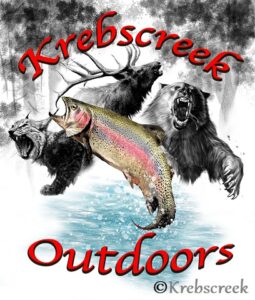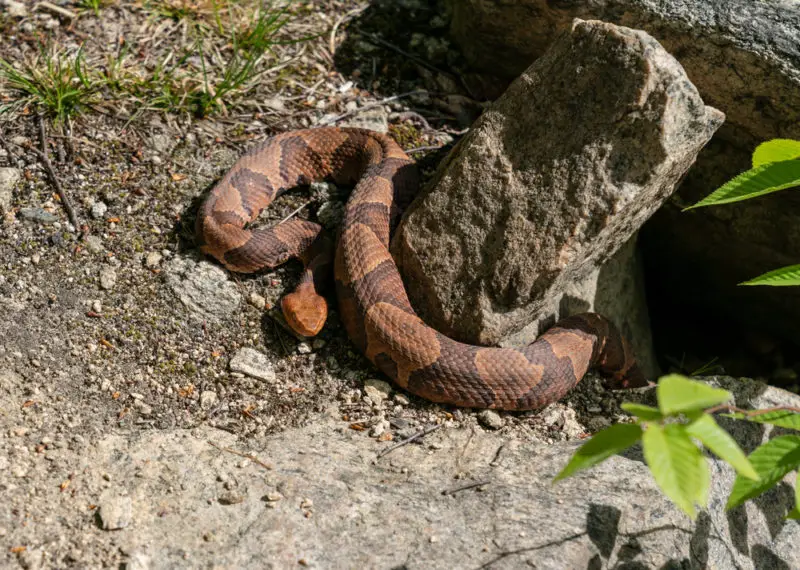The Copperhead snake (Agkistrodon contortrix) is the most widely distributed venomous snake in the eastern United States. Although it is considered endangered in New England and other areas of its range, they are flourishing and on the list of species of least concern in other areas.
States Where Copperheads Are Found
States, where copperheads are endangered, are in red.
| Alabama | Copperheads can be found in a large portion of the state and are in no danger of conservation concerns. |
| Arkansas | The copperhead is the most common venomous snake in Arkansas and is not considered endangered. |
| Connecticut | They are more stable than the timber rattlesnake, which is on the endangered list, but the copperhead has still been declining due to habitat loss, road mortality, and human persecution. |
| Delaware | Copperheads are rare in Delaware, but there is a known population in North Wilmington. |
| Florida | The copperhead has a limited range in Florida; they are found in a small area west of Tallahassee and a few counties in the western Panhandle. |
| Georgia | These snakes are found throughout Georgia, and they are not listed as protected on the State of Georgia Natural Heritage Program. |
| Illinois | The copperhead is found throughout the southern two-thirds of the state of Illinois. |
| Indiana | Only found in the southern half of the state. |
| Iowa | They are considered an endangered species in Iowa, mainly because their range just barely crosses through the state. |
| Kansas | Broad banded copperhead is considered species of least concern. |
| Kentucky | The copperhead can be found throughout the state. |
| Louisiana | The copperhead is the most common and easily identified venomous snake in Louisiana. They are found throughout the state. |
| Maryland | Listed as species of least concern, the copperhead can be found along the coastal areas, marshlands, forests, meadows, gullies, and wooded slopes, from the Blue Ridge Mountains to the Eastern Shore. |
| Massachusetts | They are listed as endangered snakes in Massachusetts. |
| Mississippi | They are found throughout the state except on the Gulf Coast and the barrier islands. |
| Missouri | The copperhead is found throughout the state of Missouri. |
| N. Carolina | In North Carolina, they are the most common and widespread venomous snake species. |
| Nebraska | They are found in the extreme southeastern corner of Nebraska in Pawnee, Gage, and Richardson counties. |
| New Jersey | New Jersey’s copperhead population is considered endangered and listed as Species of Special concern. They are sparsely distributed in the state’s northern half in parts of the Highlands, Piedmont, and Ridge-and-Valley regions. |
| New York | The copperhead is listed as a threatened species in New York. |
| Ohio | Copperheads are abundant and are found in Adams, Athens, Hocking, Jackson, Lawrence, Meigs, Scioto, Vinton, and Washington counties. |
| Oklahoma | Found throughout the eastern half of the state. |
| Pennsylvania | The copperhead is abundant and found throughout the state. |
| S. Carolina | The copperhead is found throughout the state of South Carolina. |
| Tennesee | The copperhead is abundant except for in central and western Tennessee. |
| Texas | They are found in the eastern third of the state. |
| W. Virginia | The copperhead is found throughout the state of West Virginia. |
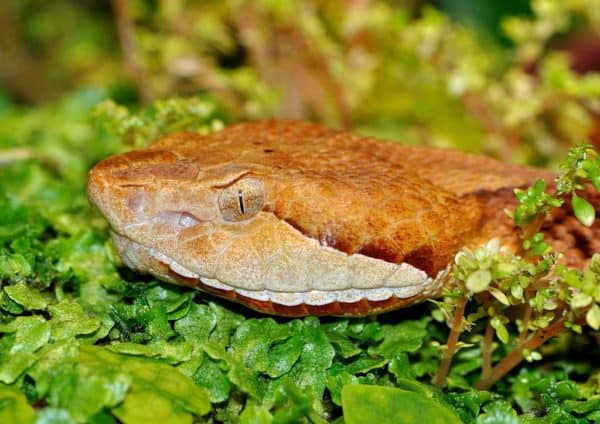
Description
The adult Copperhead typically measures anywhere from 20 – 37 inches long. Their body is moderately stout with a broad triangle-shaped head that is distinct from the neck. They have a snout that slopes down and back, making the top of the head extend further forward than the mouth. Their copper-colored eyes have vertical pupils which are typical of other pit vipers. They also have a heat-sensing pit on each side of the head between their eye and nostril. Their bodies are light brown with hourglass-shaped, dark brown crossbands that fade to a lighter brown in the center of the bands along the side of the snake. The young copperheads have a yellowish-green tail tip that they wave around to attract insects.
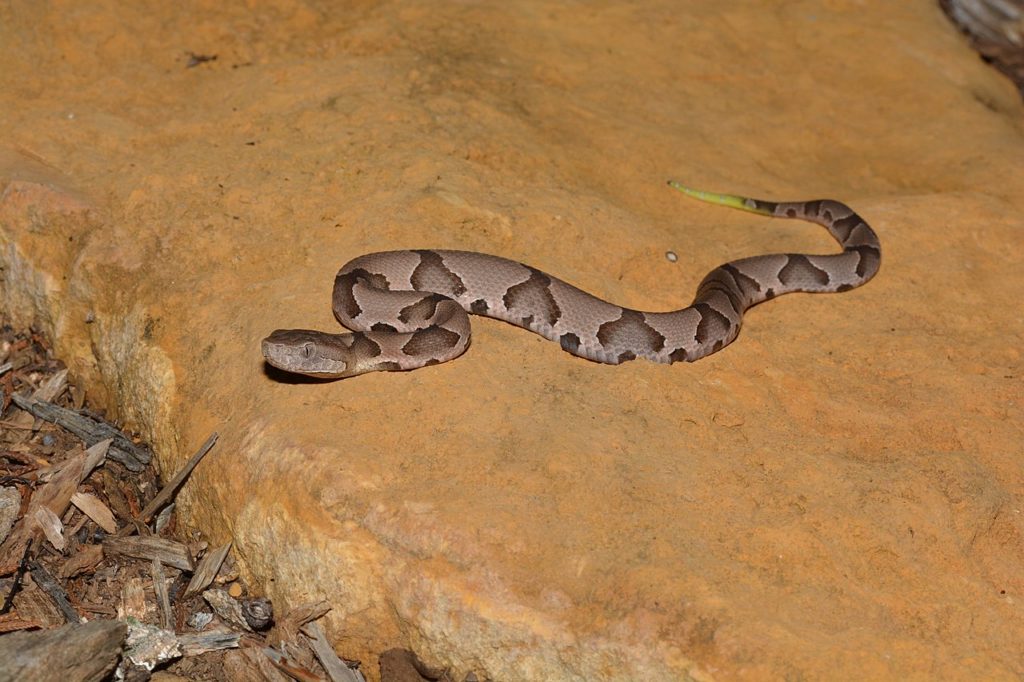
Andy Reago & Chrissy McClarren CC BY 2.0
Distinction Between Copperhead Snakes and Nonvenomous Snakes.
Countless nonvenomous snakes are killed every year because of the fear that they are copperheads. Cottonmouths (water moccasins) are their closest cousins. They have similar markings, but there are also other species of snakes that are non-venomous that are mistaken for copperheads because of their similar blotched or banded pattern markings. For instance, in New Jersey, the eastern milk snake and northern water snakes, which are more common in the state, are often mistaken for venomous snakes.
The northern water snake will flatten its head to imitate a copperhead to deter predators. Immature black racers, black rat snakes, and the eastern hognose snakes are also mistaken for venomous copperheads.
The best way to tell whether it is a venomous copperhead is to look for the hourglass pattern when looking at it from the top or the “Hershey kiss” pattern when viewing from the side of the snake. Also, a juvenile will have a yellowish-green tip on its tail.
Subspecies
In the past, there were five known subspecies of copperheads, northern copperheads (Agkistrodon contortrix mokasen), southern copperheads (Agkistrodon contortrix contortrix), osage copperheads (Agkistrodon contortrix phaeogaster), transpacos copperheads (Agkistrodon contortrix pictigaster), and broadbanded copperheads (Agkistrodon contortrix laticinctus). However, recent genetic analysis shows that the northern, southern, and osage copperheads are all regional variants of the Eastern Copperhead (Agkistrodon contortrix). While the transpacos copperhead is a regional variant of the broadbanded copperhead.
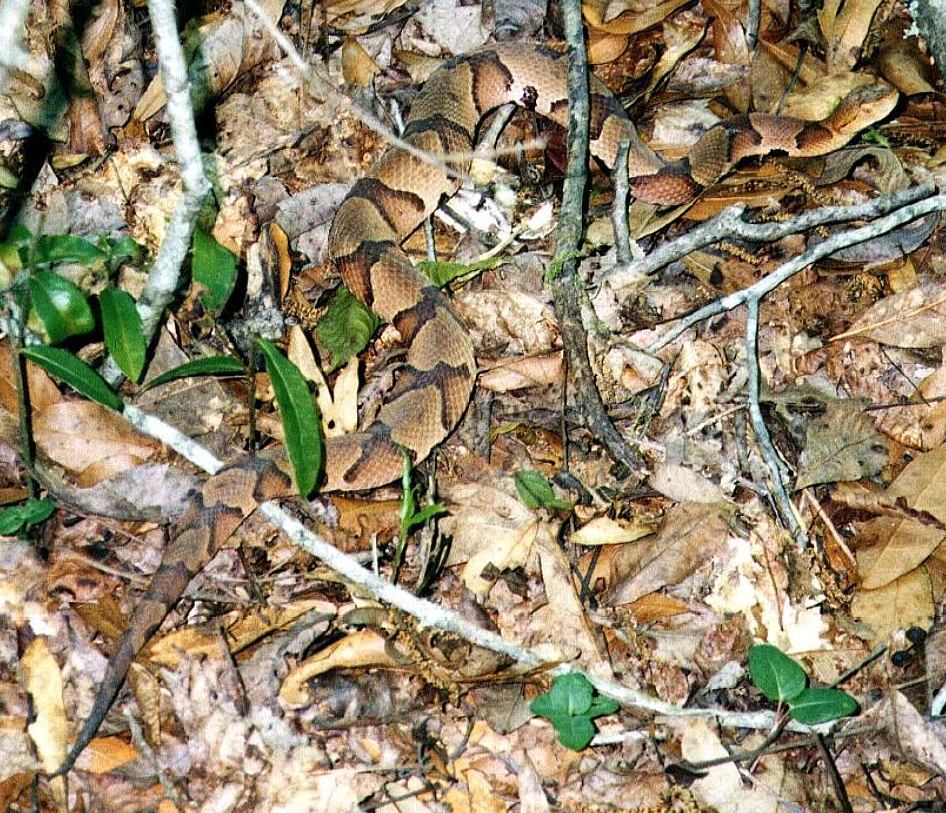
Copperhead Habitat and Diet
Den sites of the copperhead are typically associated with rocky areas and mountainous terrain, but they will circulate into surrounding fields and marshes. Their underground dens are often shared with other snake species, such as black rat snakes, garter snakes, and timber rattlesnakes. They are very good urban colonists; you can find them making their homes in the suburban environment in parks and green spaces. They are timid snakes and prefer to remain hidden within rock, woody debris, leaf litter, or foliage rather than being out in the open.
They are active hunters at night during the late summer and early fall. Heat-sensitive pits make it possible for them to see an inferred layout of their surroundings and aids in their ability to detect and strike prey when it is near range. They can see warm-blooded animals like small mammals. They have a sharp sense of smell that they use to gain information about their surroundings and can locate areas where their prey is active. They may remain coiled and motionless for days waiting to ambush their prey when it comes by.
Copperheads are particular about what they choose to eat. Adult copperhead’s main diet consists of small mammals like mice, shrews, and voles, but they may also eat frogs and occasionally small birds. Juveniles eat insects.
Reproduction
Copperheads reach sexual maturity at about 4 years of age and breed in the late summer, but not every year; sometimes, gravid females will bear their young for several years in a row and then not breed for a long time. They give live birth to 4-7 babies, but they are known to have up to 20. These little snakes are 8 inches long (22 cm). They are born with a yellowish-green tail that they will keep for about a year. Newborn copperheads are born with venom and ready to defend themselves. These snakes are generally not aggressive but will bite if they feel threatened.
Venom
Like all pit vipers, Copperheads have long, hollow fangs in the front of their mouth. These fangs are hinged so that they fold back against the roof of the mouth when the mouth is closed and automatically brought forward when the mouth is opened. They use their fangs to inject their venom into their prey, and Copperheads use the venom as a defense or to capture their prey. Because their venom is crucial to feeding, they may not use their venom when biting defensively. This is referred to as a dry bite. Copperheads are responsible for the majority of venomous snake bites in the United States. About 25% of snake bites are dry defensive bites.
Copperheads have hemolytic venom, and this type of venom breakdown the red blood cells in the bitten animal. Their prey eventually dies, and after that, the snake is able to swallow it.
Copperhead bites, while being painful and causing sickness, rarely lead to death in humans. However, if bitten, seek medical assistance immediately.
Some of the symptoms you may experience when a venomous snake bites you include:
- Discoloration in the area of the bite.
- Swelling in the area of the bite.
- Loss of muscle coordination.
- Tingling sensation in the area of the bite.
- Feeling nauseous.
- Having a faster heartbeat or rapid pulse.
What Should You Do If You Are Bitten?
If you think you or someone you know or encounter has been bitten by a rattlesnake, time is precious because of the effects that the venom causes on the human body. It is essential to seek medical attention immediately if you suspect that a rattlesnake or other venomous snake bit you. Take these first aid steps in the case that a rattlesnake or other venomous snake has bitten you or someone around you:
- Remain calm and limit your movements. Do not run. If you must hike back to a vehicle, do it in a calm, deliberate manner. Put as little stress on your heart as possible.
- Keep the area of the snake bite below the heart level and never above heart level. Keeping the bite below the heart level will reduce the venom’s flow, while holding the bite above your heart level will increase the venom’s flow.
- Since the snake bite will swell, it is advised to remove all constricting items such as bracelets, watches, or rings because the area will most likely begin swelling.
- You can wash the bite area like you would any other wound with soap and water.
- You may cover the bite area with a moist dressing to reduce the swelling and some of the discomfort you or the person that has been bitten may be feeling.
- Get medical attention as soon as possible. If you or someone has a phone, call the hospital or ambulance to tell them a venomous snake may have bitten you so they can have the anti-venom ready to give you as soon as you arrive.
A person who a venomous snake has bitten may go into shock. If this happens, you should lay them flat and cover them with a blanket.
After a poisonous snake has bitten someone, they will attempt to kill it to take it in to be identified. This is rarely a good idea, and it’s potentially a good way to get bit again. Remember, a dead snake can still bite you. Also, consider that severed snakeheads can still bite and envenomate and often do. If you have a phone, take a picture of the offending reptile. Otherwise, get started on your way to the doctor.
Be Aware of Your Surroundings
Even though the copperhead has the ability to inflict harm, they are docile and non-aggressive and would rather curl up and stay hidden rather than be noticed. Unless they are handled, provoked, or hurt, these snakes will not bite.
The following is taken from the article Avoiding Snake Bite and Snake Bite Survival.
If you are hiking, be aware of your surroundings. It’s easy to become complacent, but in snake country, be especially vigilant about where you place your hands and feet. All it takes is a split second of distraction to place one of your limbs within a venomous snake’s strike zone.
If your traveling through dense undergrowth, using a walking stick is a good idea. Tap the ground in your route to give those poisonous serpents a bit of advance notice that you’re coming through. Also, use your walking stick to move any litter or foulage that obstructs your view of where you’re going to place your feet.
Quick Tips to Keep Snakes Out of Yard
- Clean up piles of debris and other materials lying around your yard.
- Keep your wood piles stacked off the ground and away from your house.
- Make sure your siding is securely attached to the bottom edge of your house.
- Trim shrubs one foot off the ground to eliminate ground cover.
- Don’t allow piles of leaves to collect along the foundation of the house or under the deck.
- Seal cracks along the foundation of your house.
Recent Posts
The only venomous snakes in Washington State are Northern Pacific Rattlesnakes. The Northern Pacific Rattlesnake (Crotalus oreganus oreganus) is a sub-species of the Western Rattlesnake. Anyone...
Skunks are not classified as true hibernators. But they go into a state of torpor when the weather gets cold. Skunks are light sleep hibernators, along with opossums, bears, and raccoons. ...
